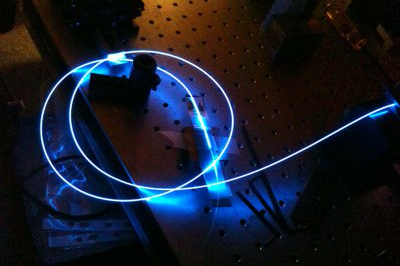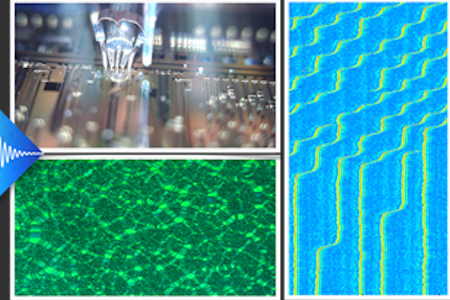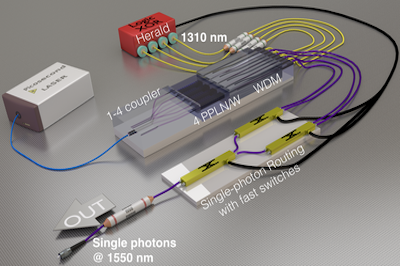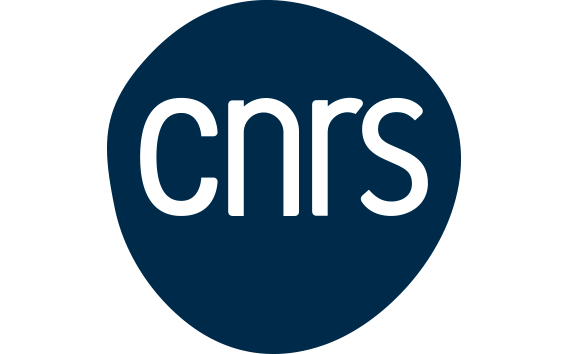Photonics
Photonics is the science of the generation, control, and detection of light. In this area, the research at INPHYNI ranges from the analysis of physical and dynamic phenomena (classical and quantum) to the development of photonic materials, components, and systems. More specifically, research topics include:
- dynamics of complex optical systems,
- biophotonics and neuroscience,
- light modulation,
- adaptive holographic systems,
- control methods for ultra-short laser pulses,
- special fiber optics for optical telecommunication, laser sources, amplifiers, and sensors,
- optical parametric oscillators and frequency converters,
- quantum optics-enhanced metrology,
- long-distance quantum communication systems.
The research groups of the Photonics axis have numerous academic collaborators, both nationally and internationally, as well as industrial partners such as THALES, FASTLITE, Prysmian, and various small and medium-sized businesses.
Coordonnateur: Fabrice Raineri
Fibre optics and applications

- Description
-
The Fibre Optics and Applications team manufactures and studies specialty optical fibres for devices with applications in telecommunications, metrology, original laser sources for industry, biomedical or environmental monitoring. To optimize the performance of these components and subsystems we study the properties of the fibre materials and their modifications resulting from nano-structuring or doping operations, in particular rare-earth ions. The properties of the dopants in these materials depend on their environment and can be modified by the radiation to which they are subjected. These modifications are also studied in aging experiments (degradation under irradiation), sensitivity to power (optical damage, photo-induced attenuation). The team relies on the fibre optics manufacturing platform and its optical and spectroscopic characterization equipment.
- Team members
-
Benabdesselam Mourad
Blanc Wilfried – group leader
Dussardier Bernard
Grandvillain Marjorie
Legrand Apolline
Mady Franck
Complex photonic systems and materials

- Description
-
The "Complex Photonic Systems and Materials" group specializes in the analysis of the fundamental physical properties of new optical components and architectures developed to meet the challenges of modern photonics such as advanced imaging, ultra-fast optics, neuromorphic photonics, integrated optics and biophotonics. To meet these challenges, our research activities propose to develop new optical sources by integrating passive or active materials into complex architectures to manipulate and modulate the fundamental properties of light such as frequency, coherence, spatio-temporal dynamics and transport in complex optical networks.
The projects developed in our group rely on various experimental platforms such as liquid crystal devices for the manipulation of ultra-short laser pulses, nonlinear optics integrated on Lithium Niobate, and semiconductor materials and lasers emitting in the visible and near infra-red. - Team members
-
Baldi Pascal
Barland Stéphane
Dahes Sana Samya
Dhingra Shallu
Forget Nicolas – group leader
Giudici Massimo
Gudin Félix
Huyet Guillaume
Iachkula Varvara
Jullien Aurélie
Lippi Gian-Luca
Madiot Guilhem
Marcadier Matis
Marconi Mathias
Martin Inès
Metayrek Youssef
Mitov Michel
Montes Carlos
Monvoisin Natan
Raineri Fabrice
Sarrazin Lucas
Sawant Rajath - More info
Quantum photonics and information

- Description
-
The Quantum Photonics & Information team is one of the leading group in the field of quantum photonics engineering and technologies. Its research topics lie in fundamental and applied quantum optics and information. More specifically, photonic systems operating in the telecom range are realized for demonstrating quantum supremacy in communication and metrology applications. Those devices, mostly based on integrated photonic circuits, make it possible to exploit simultaneously highly efficient nonlinear optical interactions and the active routing of information. This is an actual asset for the generation of on-demand engineered quantum states, based whether on discrete, continuous, or hybrid variables. These devices are developed in close collaboration with the Integrated Nonlinear Optics (ONLI) team and its technological platform (Optinil).
- Team members
-
Alibart Olivier
Aschieri Pierre
Bellando De Castro Louis
Bensemhoun Adrien
Carvalho De Salles Daniel
Cohen Mathis
Dalidet Romain
D'Auria Virginia
Degert-Bouvrais Hugo
Dumas Valentin
Esposito Gaspare
Etesse Jean
Khlifa Marouane
Labonté Laurent
Lecaron Nathan
Martin Anthony
Naim Hani
Petitjean Antoine
Pelet Yoann
Picholle Eric
Sauder Grégory
Tanzilli Sébastien – group leader
Troisi Tess
Zeidan Wadad


